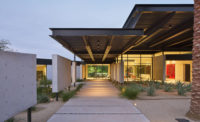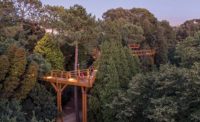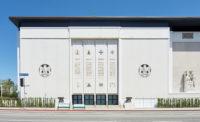Twenty-five years ago, when Steven Spielberg finished directing the movie Schindler’s List, he realized his work was not done. Many Holocaust survivors’ stories still needed to be told—to preserve their memories, to bear witness, to learn from the past. He soon established the Shoah Foundation, dedicated to capturing such personal narratives on video. The organization has since archived more than 54,000 recordings in 43 languages and expanded its mission to seek out testimonies from genocides in Rwanda, Cambodia, Guatemala, Armenia, and elsewhere. Educational organizations worldwide subscribe to the archive. But the institute had no publicly accessible headquarters until last November, when Santa Monica, California–based Belzberg Architects (BA) converted the top floor of a University of Southern California (USC) library into the foundation’s 10,000-square-foot “mother ship.”
Additional Content:
Jump to credits & specifications
Now called the USC Shoah Foundation (USCSF), the institute began, in 1994, in trailers at Universal Studios, joining USC in 2006 and moving to cubicles on campus. Lacking was accommodation for visitors, teamwork, or programs that could include distinguished speakers, outreach to school children, and scholarly research residencies. The staff needed an open, collaborative environment with flexibility, and respite from the emotionally intense work.
BA principal Hagy Belzberg, knowing his own family’s Holocaust history, understood the importance of a safe-feeling, comfortable setting, particularly for survivors who might visit, work here, or come to record testimony. Now the elevator doors open directly into a soothing atmosphere, distinct from the existing library beneath. The lighting is subdued, sobering, filtered overhead through amber metal mesh. A forest of pillars—digital kiosks—invites individuals to explore USCSF’s offerings, as live lectures, or other content, animate a large, interactive back wall. While immersive, the space also connects with views outdoors, a conscious measure, across the entire floor, to keep it from ever seeming confining.
Bordering this entry hall is a daylit zone, with a suspended word-sculpture integrating phrases from one survivor’s testimony. With glass doors leading into other spaces, this area has a welcoming, luminous transparency, but unauthorized visitors can go no farther. “Given the subject matter’s sensitivity,” says Belzberg, “it needed high security without losing the feeling of openness. It’s a subtle balance.”
The west wing includes meeting and research areas, plus places the public can experience by invitation or tour. One room offers a survivorled, virtual-reality walk through a concentration camp while, in a lounge, visitors can converse, via artificial intelligence, with a videoed Holocaust survivor, who appears life-size, onscreen.
The east wing provides staff workstations, with a diagonal layout that maximizes openness and options ranging from group to individual areas, from conventional desks to standing or mobile choices. Work counters along the windows face outdoors, and slide-away glass walls can convert enclosed conference rooms into wide-open “town hall” configurations. The scheme is a collage of “neighborhoods,” defined by changes in flooring (from hardwood to carpeting), in texturally rich, acoustic material overhead, and in textiles from countries in USCSF’s orbit. Along with the patterned fabrics and oak floors, an open kitchen and furnishings such as sofas and poufs convey an intentionally homey feel.
“It’s phenomenal,” says USCSF managing director Kim Simon. “This design supports the very difficult work we do, both together and apart. There’s peacefulness and serene light; nothing is superfluous—everything’s here to meet a need. That has real integrity, and giving voice to people who have suffered has integrity. It’s rare to match your physical space with your mission. Yet that has been accomplished here.”
CreditsArchitect: Belzberg Architects, 2321 Main Street, Santa Monica, California, 90405, 310.453.9611, www.belzbergarchitects.com
Personnel in architect's firm who should receive special credit: Hagy Belzberg FAIA OAA (Partner-in-Charge), Lindsey Sherman Contento RA and Cory Taylor AIA (Project Manager/Project Architect), Ashley Coon, Adrian Cortez, Barry Gartin, Aaron Leshtz, Corie Saxman
Interior designer: Belzberg Architects, Jennifer Wu (Interior Design Lead), J. Joshua Hanley, Alexis Roohani, Susan Nwankpa Gillespie, Katelyn Miersma, Melissa Yip
Engineers Structural Consultant: BuroHappold MEP Engineer: BuroHappold
Consultants: Project Management: USC Capital Construction Development Lighting Design: BuroHappold Signage and Wayfinding: Egg Office Access Control: Exante 360 Acoustic Design: Newsom Brown Fire Sprinkler: Arup Exhibition Designer: The Maude Group AV Design: MAD Systems Specifications: Arcom
General contractor: Clune Construction
Photographer: Bruce Damonte |
SpecificationsDoors Special doors: Sliding Stacking Wall: PK30
Hardware Cabinetry Hardware: Edgecliff Pull: Schoolhouse Alberta Pull: Schoolhouse
Interior Finishes Acoustical ceilings: Softfold: Arktura Vapor with custom perforation pattern: Arktura Custom Cabinetry: Seeley Brothers Custom Bench Seating: Spectrum Oak Paints and stains: Vista Paint Wall coverings: Soft Sound: Arktura; Carpet: Overlay Accent II: Tandus Centiva Special interior finishes unique to this project: Area Rugs: West Berlin Area Rug: Lindstrom Rugs Wood Flooring: Durango European Oak (Engineered): via Wood-Concepts Upholstery / Upholstered Walls: Custom upholstery based on traditional regional patterns: Opuzen Custom wall upholstery based on traditional regional patterns: Opuzen Acoustical Wall Upholstery: Guildford of Maine Drapery: Time 300 Sheer Fabric: Maharam Stone / Solid Surface Countertops: Saint Pierre Linear Marble: Stone Source Seagrass Limestone: Walker Zanger Café Argento Marble: Walker Zanger Catalina Mist Marble Mosaic: Daltile Sleek Concrete: Caesarstone
Furnishings Workstations: Intuity Benching System: BANGDESIGN & Haworth Design Studio Task chairs: Projek Task Chair: Orangebox Limited via Teknion Lounge furniture: Item Sofa: Bernhardt Designs Log Lounge Chairs: Pedrali via Morlen Sinoway Bubble Ottoman: Roche Bobois Nivola Armchair: Poltrona Frau Laurel Side Table in Marble: De La Espada via Morlen Sinoway Strato Coffee Table: Living Divani via Casa Design Boston Bikini Island Benches: Moroso via DDC NYC Bardot Chairs: Bernhardt Designs Duda Counter Stool: Sossego via LGS Group Conference room furniture: Custom Walnut/Lacquer Executive Conference Table: Monte Allen Collection Flex Executive Chair: Andreau World via Lauren Todd and Associates SW-1 Conference Chair: Coalesse via Tangram Interiors SW-1 Low Collaborative Conference Table: Coalesse via Tangram Interiors Metal Wolfgang Chair: Fornasarig via Morlen Sinoway Dealers: Pacific Office Interiors Office Furniture Group, Inc. Tangram Interiors
Lighting Stem mounted downlighting: iGuzzini/Sisremalux Decorative lighting: Brass T Ceiling Fixture: Allied Maker Middle Sky Bang Pendant: STICKBULB Tri Pendant Light: Resident |










Post a comment to this article
Report Abusive Comment